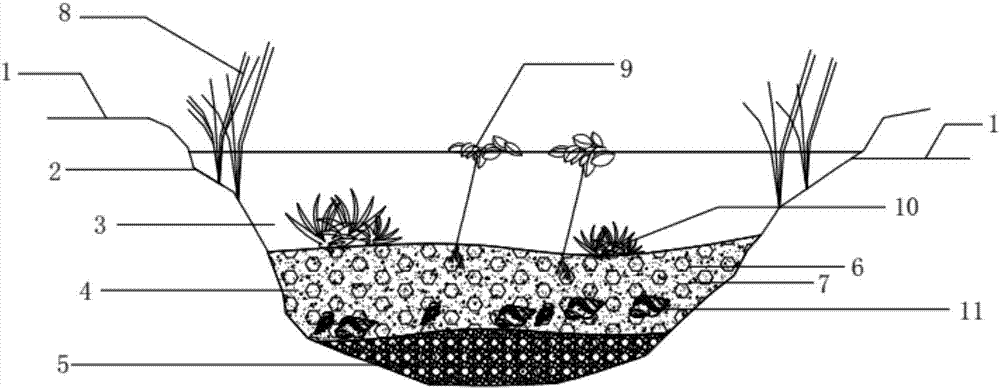Method for reducing nitrogen and phosphorus pollution of water body by transforming marsh lands in riparian zones and reservoir bank zones
A technology for riparian zones and depressions, applied in the field of river ecological restoration, can solve problems such as danger, impact on the landscape and ecosystem functions of riparian zones and reservoir zones, and achieve the goals of convenient operation, improvement of biodiversity and ecological functions, and optimal configuration Effect
- Summary
- Abstract
- Description
- Claims
- Application Information
AI Technical Summary
Problems solved by technology
Method used
Image
Examples
Embodiment 1
[0034] A method for transforming riparian and reservoir bank depressions to reduce nitrogen and phosphorus pollution in water bodies, the steps of which are:
[0035] 1. Depression shape transformation: select 5 depressions 2 that are relatively close to each other on the reservoir bank, and keep the average depth of depressions 2 at about 1m through excavation or landfilling. The deepest depression 2 does not exceed 1.5m, and the average area of depressions 2 55m 2 .
[0036] 2. Connection of depression water system: connect depression 2 with adjacent river channels by digging ditches or laying concrete culverts, so that the river water flowing in by gravity can flow freely in depression 2 system and be discharged into the reservoir through ditch 1. Ditch 1 has a width of 50cm and a depth of no more than 0.5m; the inner diameter of the culvert is 40cm.
[0037] 3. Restoration of the base of the depression: Lay a gravel layer 5 with a thickness of about 10cm in the lower l...
PUM
 Login to View More
Login to View More Abstract
Description
Claims
Application Information
 Login to View More
Login to View More - R&D
- Intellectual Property
- Life Sciences
- Materials
- Tech Scout
- Unparalleled Data Quality
- Higher Quality Content
- 60% Fewer Hallucinations
Browse by: Latest US Patents, China's latest patents, Technical Efficacy Thesaurus, Application Domain, Technology Topic, Popular Technical Reports.
© 2025 PatSnap. All rights reserved.Legal|Privacy policy|Modern Slavery Act Transparency Statement|Sitemap|About US| Contact US: help@patsnap.com

